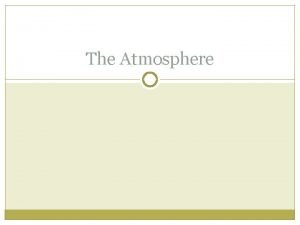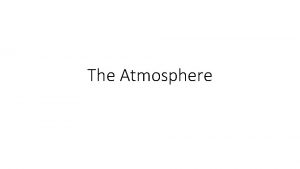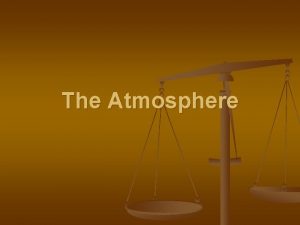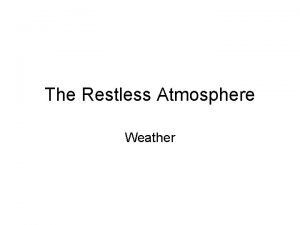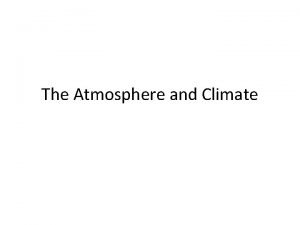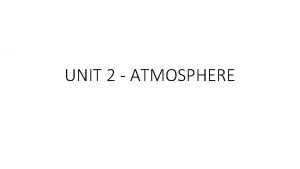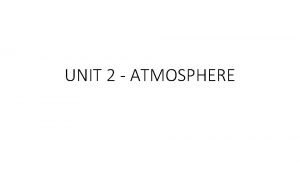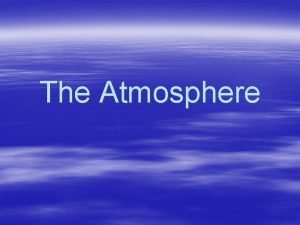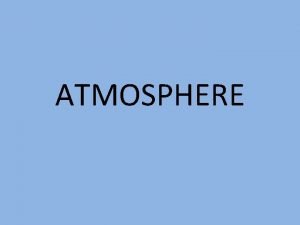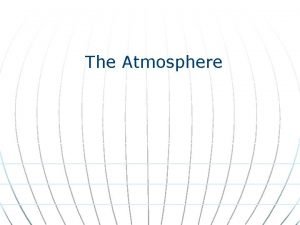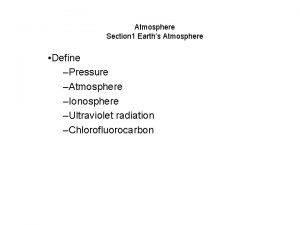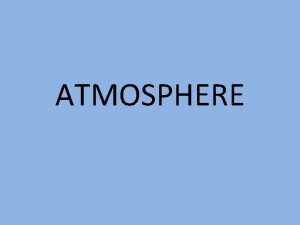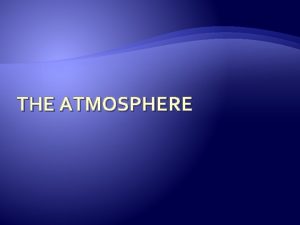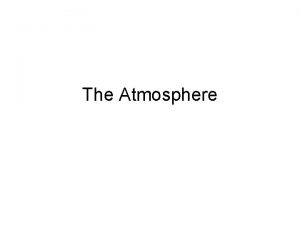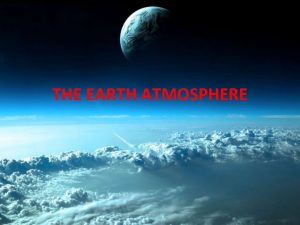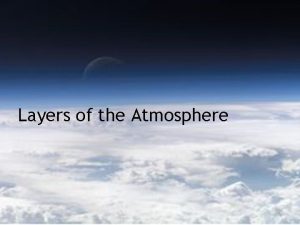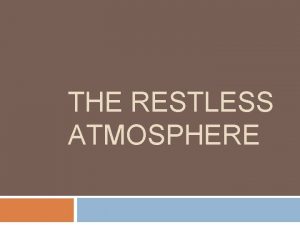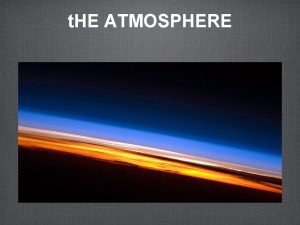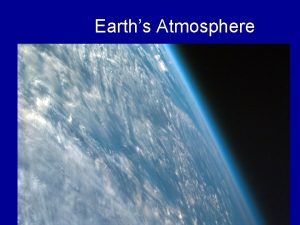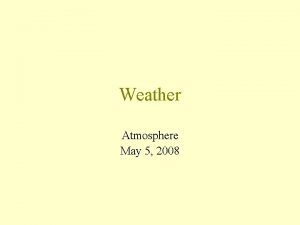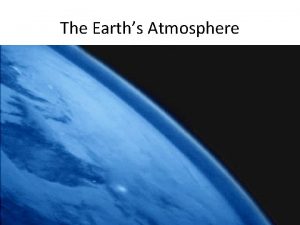The Atmosphere Characteristics of the Atmosphere It is



























- Slides: 27

The Atmosphere

Characteristics of the Atmosphere It is a blanket of moisture-filled air that surrounds the earth. It consists 78% nitrogen, 21% oxygen, 1% other gases (argon, carbon dioxide and water) It has ozone in its upper layers which absorb harmful UV rays from the sun. It protects us from meteors (they vaporize due to the friction with the atmosphere) Video It keeps the earth warm enough for us to live as it helps trap heat.

Video

Layers of Atmosphere

Layers Again….

Layers in Order…(starting from the Earth upwards) 1. Troposphere – up approx. 12 km Closest to the Earth’s surface. Where all weather takes place. Air is in constant motion with both vertical and horizontal currents. Pressure decreases as altitude increases. Has very small amounts of ozone. 2. Tropopause Contains more ozone than troposphere. Is warmer than the troposphere because it absorbs UV rays from the sun.

3. STRATOSPHERE 12 -50 km above the Earth’s surface Higher levels of ozone than any other layer 4. MESOSPHERE Temperatures are very low here 50 to 80 km above the earth Very low density Meteors from space usually burn up in this layer due to air friction

What is Ozone? About 19 -30 kilometres above the Earth is a layer of gas called ozone, which is a form of oxygen. Oxygen = O 2 Ozone = O 3 Ozone is produced naturally in the atmosphere.

5. Thermosphere (AKA –Ionosphere) 80 km to 500 km from Earth’s surface. Fewest air molecules Also called ionosphere b/c the Sun’s radiation causes particles to become electrically charged ions. The Northern and Southern lights (aurora borealis) are produced by these ions. These charged particles also reflect radio signals so they can travel around the world.

6. Exosphere Outer limits! SPACE The thinest, outermost layer of the atmosphere Very few particles (few hydrogen particles) spread out very far. -DISCOVERY COMMERCIAL

THE CARBON CYCLE CHAPTER 2. 5

A Little Background Info … Organic Substances: • Always contain atoms of carbon and hydrogen and often contain oxygen and nitrogen atoms. • EXAMPLES: – Proteins, sugars, and fats Inorganic Substances: • Matter that doesn’t contain a combination of carbon and hydrogen atoms • EXAMPLES: – Carbon Dioxide (CO 2), water (H 2 O), and ammonia (NH 3)

CYCLING OF ORGANIC MATTER • The materials used in building the bodies of living organisms are limited to the atoms and molecules that make up the planet. • To maintain life on Earth, matter must be recycled. • Every carbon atom is recycled time and time again into new life forms.

The Cycle of Matter • Fox CO 2 + Energy Rabbit Plant Leaves Feed Matter Decomposition Decomposers or Organic Matter Plant Roots Inorganic Materials Inorganic Molecules Bacteria

THE CARBON CYCLE • Carbon is an element • Carbon atoms are the basis for all living things (called organic matter) and for all matter that was once living (called detritus).

• Carbon is stored in FOUR places: – Living things – The atmosphere – The ocean – The earth’s crust These storage places are called carbon sinks.

• Carbon is removed from the atmosphere by plants when they photosynthesize to make sugar. Photosynthesis Reactants Products • 6 CO 2 + 6 H 2 O + light = C 6 H 12 O 6 +6 O 2 Carbon Dioxide + water + light = Sugar ( Glucose) + oxygen

• Carbon is returned to the atmosphere by plants and by animals when they respire or exhale. Reactants C 6 H 12 O 6 + O 2 Sugar + oxygen = Respiration Products = CO 2 + H 2 O carbon dioxide + water • Please fill in chart on page 62.

• Photosynthesis and cellular respiration are complementary processes. • The carbon that they use is repeatedly cycled through both processes, this relationship is often called the CARBON CYCLE

• Most of the carbon that forms living organisms is released to the atmosphere or water as carbon dioxide from dead decaying organisms. • Under certain conditions the decay process is delayed, and the organic matter may be converted into rock or fossil fuels such as coal, petroleum and natural gas.

• This carbon is not released until the combustion process takes place through burning the fuels.

Reservoirs for Inorganic Carbon • Carbon, when not in organic form, can be found in three main reservoirs (storage areas): • The atmosphere • The oceans • The Earth’s crust

The Ocean • Carbon is found in sea shells and bones. • When these fall to the bottom of the oceans and get covered with sediment, they decompose over millions of years to form oil (one of the fossil fuels).

• Shells and Bones (Millions of tonnes of soil) Sink to the bottom of the ocean Covered by sediment (Millions of years) Form oil (example: Offshore drilling NFLD)

Reservoirs for Organic Carbon • Organic carbon is also held in reservoirs – the bodies of living things. • All living things die and decomposition eventually returns the carbon to the cycle in inorganic form.

One Important Exception • Bogs – store huge quantities of carbon in organic form. • Bogs have very little oxygen, therefore decomposition is very slow. • Carbon atoms may remain locked away in dead plant matter (peat) for many years in a bog. • When plants decompose in a bog, they form peat that can get trapped under sediments over millions of years and form coal (another form of fossil fuel)

PLANTS Die in a bog and form Peat Millions of years and tonnes of pressure form coal
 Characteristics of the atmosphere
Characteristics of the atmosphere Hình ảnh bộ gõ cơ thể búng tay
Hình ảnh bộ gõ cơ thể búng tay Lp html
Lp html Bổ thể
Bổ thể Tỉ lệ cơ thể trẻ em
Tỉ lệ cơ thể trẻ em Chó sói
Chó sói Chụp tư thế worms-breton
Chụp tư thế worms-breton Hát lên người ơi
Hát lên người ơi Môn thể thao bắt đầu bằng chữ đua
Môn thể thao bắt đầu bằng chữ đua Thế nào là hệ số cao nhất
Thế nào là hệ số cao nhất Các châu lục và đại dương trên thế giới
Các châu lục và đại dương trên thế giới Công của trọng lực
Công của trọng lực Trời xanh đây là của chúng ta thể thơ
Trời xanh đây là của chúng ta thể thơ Mật thư anh em như thể tay chân
Mật thư anh em như thể tay chân Làm thế nào để 102-1=99
Làm thế nào để 102-1=99 Phản ứng thế ankan
Phản ứng thế ankan Các châu lục và đại dương trên thế giới
Các châu lục và đại dương trên thế giới Thơ thất ngôn tứ tuyệt đường luật
Thơ thất ngôn tứ tuyệt đường luật Quá trình desamine hóa có thể tạo ra
Quá trình desamine hóa có thể tạo ra Một số thể thơ truyền thống
Một số thể thơ truyền thống Cái miệng nó xinh thế chỉ nói điều hay thôi
Cái miệng nó xinh thế chỉ nói điều hay thôi Vẽ hình chiếu vuông góc của vật thể sau
Vẽ hình chiếu vuông góc của vật thể sau Nguyên nhân của sự mỏi cơ sinh 8
Nguyên nhân của sự mỏi cơ sinh 8 đặc điểm cơ thể của người tối cổ
đặc điểm cơ thể của người tối cổ Thế nào là giọng cùng tên? *
Thế nào là giọng cùng tên? * Vẽ hình chiếu đứng bằng cạnh của vật thể
Vẽ hình chiếu đứng bằng cạnh của vật thể Phối cảnh
Phối cảnh Thẻ vin
Thẻ vin
